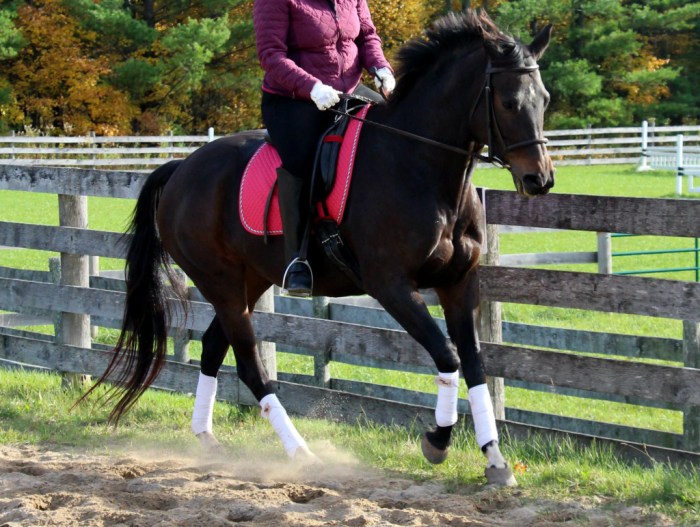In the equestrian world, the difference between lope and canter is a fundamental distinction that shapes the performance and versatility of horses. Understanding these two gaits is crucial for riders seeking to master horsemanship and navigate the intricacies of equine movement.
This comprehensive guide delves into the characteristics, biomechanics, purpose, and training methods associated with lope and canter. By exploring these aspects, we unravel the nuances that set these gaits apart, empowering riders with the knowledge to harness their horses’ potential.
Definition of Lope and Canter: Difference Between Lope And Canter

Lope and canter are two distinct gaits in equestrianism, each characterized by its own unique rhythm and footfall pattern. Understanding the differences between these gaits is essential for effective horse training and riding.
Characteristics of a Lope Gait
- Three-beat gait with a period of suspension.
- The horse’s back remains relatively level.
- The horse’s head and neck are held low.
- The horse’s legs move in a diagonal sequence: outside foreleg, inside hindleg, outside hindleg, inside foreleg.
Characteristics of a Canter Gait
- Three-beat gait with a period of suspension.
- The horse’s back rocks from side to side.
- The horse’s head and neck are held higher than in a lope.
- The horse’s legs move in a lateral sequence: outside foreleg, outside hindleg, inside foreleg, inside hindleg.
| Characteristic | Lope | Canter |
|---|---|---|
| Rhythm | Three-beat | Three-beat |
| Suspension | Yes | Yes |
| Back Movement | Level | Rocking |
| Head and Neck Position | Low | Higher |
| Leg Movement Sequence | Diagonal | Lateral |
Biomechanics of Lope and Canter
Biomechanics of a Lope Gait
During a lope, the horse’s body weight is distributed evenly between its front and hind legs. The horse’s back remains relatively level, and the head and neck are held low. The horse’s legs move in a diagonal sequence, with the outside foreleg and inside hindleg moving forward simultaneously, followed by the outside hindleg and inside foreleg.
Biomechanics of a Canter Gait
During a canter, the horse’s body weight is shifted more towards the outside foreleg. The horse’s back rocks from side to side, and the head and neck are held higher than in a lope. The horse’s legs move in a lateral sequence, with the outside foreleg and outside hindleg moving forward simultaneously, followed by the inside foreleg and inside hindleg.
Similarities and Differences in Biomechanics
Both lope and canter are three-beat gaits with a period of suspension. However, they differ in the way that the horse’s weight is distributed and the way that the horse’s legs move. In a lope, the weight is distributed evenly between the front and hind legs, and the legs move in a diagonal sequence.
In a canter, the weight is shifted more towards the outside foreleg, and the legs move in a lateral sequence.
Purpose and Usage of Lope and Canter

Purpose and Usage of a Lope Gait
The lope is a versatile gait that can be used for a variety of purposes, including trail riding, pleasure riding, and competition. It is a relatively comfortable gait for both the horse and the rider, and it allows the horse to cover ground quickly and efficiently.
Purpose and Usage of a Canter Gait
The canter is a faster gait than the lope, and it is typically used for racing and jumping. It is a more demanding gait for both the horse and the rider, but it allows the horse to cover ground more quickly.
The canter can also be used for dressage and other equestrian disciplines.
Advantages and Disadvantages of Lope and Canter Gaits
- Advantages of Lope:Comfortable for both horse and rider, versatile, efficient.
- Disadvantages of Lope:Slower than canter, less suitable for racing and jumping.
- Advantages of Canter:Faster than lope, suitable for racing and jumping.
- Disadvantages of Canter:More demanding for both horse and rider, less comfortable than lope.
Training for Lope and Canter

Training Methods for a Lope Gait
Training a horse to lope requires patience and consistency. The following steps can be used to train a horse to lope:
- Start by teaching the horse to trot.
- Once the horse is comfortable trotting, gradually increase the speed and encourage the horse to break into a lope.
- Use verbal cues and leg aids to help the horse maintain a steady lope.
- Practice loping in both directions.
Training Methods for a Canter Gait
Training a horse to canter is similar to training a horse to lope. The following steps can be used to train a horse to canter:
- Start by teaching the horse to lope.
- Once the horse is comfortable loping, gradually increase the speed and encourage the horse to break into a canter.
- Use verbal cues and leg aids to help the horse maintain a steady canter.
- Practice cantering in both directions.
Tips for Transitioning between Lope and Canter Gaits, Difference between lope and canter
Transitioning between lope and canter gaits can be challenging for both the horse and the rider. The following tips can help to make the transition smoother:
- Use verbal cues and leg aids to signal the horse that you want to change gaits.
- Be patient and allow the horse time to make the transition.
- Practice transitioning between gaits in both directions.
Top FAQs
What is the primary difference between lope and canter?
Lope is a three-beat gait with a moment of suspension, while canter is a four-beat gait with no moment of suspension.
Which gait is faster, lope or canter?
Canter is generally faster than lope.
What are the advantages of using lope?
Lope is a comfortable and energy-efficient gait that is suitable for long distances.